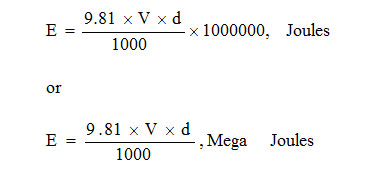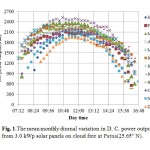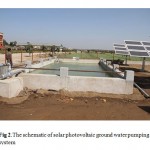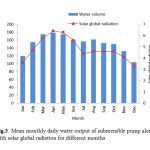Design Approach for Solar Photovoltaic Ground Water Pumping System for Eastern India
Atiqur Rahman1 * and B.P. Bhatt1
1
ICAR Research Complex for Eastern Region,
PO: Bihar Veterinary College Campus,
Patna,
800 014
Bihar
India
DOI: http://dx.doi.org/10.12944/CWE.9.2.25
Copy the following to cite this article:
Rahman A, Bhatt B. P. Design Approach for Solar Photovoltaic Ground Water Pumping System for Eastern India. Curr World Environ 2014;9 (2) DOI:http://dx.doi.org/10.12944/CWE.9.2.25
Copy the following to cite this URL:
Rahman A, Bhatt B. P. Design Approach for Solar Photovoltaic Ground Water Pumping System for Eastern India. Curr World Environ 2014;9(2). Available from: http://www.cwejournal.org/?p=6124
Download article (pdf) Citation Manager Publish History
Select type of program for download
| Endnote EndNote format (Mac & Win) | |
| Reference Manager Ris format (Win only) | |
| Procite Ris format (Win only) | |
| Medlars Format | |
| RefWorks Format RefWorks format (Mac & Win) | |
| BibTex Format BibTex format (Mac & Win) |
Article Publishing History
| Received: | 2014-03-20 |
|---|---|
| Accepted: | 2014-04-27 |
In Eastern India most of the land holdings are of small category and food production systems are often been risky and relatively of low return due to erratic rainfall. This is expected to worsen in coming decades under climate change.1-2 These smallholders could playan increasingly important role in food production if they had the access of irrigation water.3 The assuredirrigation cold provide ample opportunities to the farmers to invest in high yielding seeds, grow high valued crops andcrop diversification as promotion of irrigation itself is an strategy for poverty reduction, climate adaptation and foodsecurity.4-5 The average solar radiation, incident over the Eastern India landscape, varies between 4-6.4 kWh/m2/daywith 250 -300 clear sunshine days.6-7 Therefore, promotion of solar energy,particularly for groundwater pumping is indeed required in view of current energy deficit and high growth rate of energy consumption in agricultural.8 In addition to this the use of modern irrigation technologies could be reducing the overexploitation of groundwater and environmental degradation.9-10
System Configuration and Size of Pump and Solar Array
In solar photovoltaic water pumping system main components are the solar array, power conditioning unit and solar tracking mechanism.If water source is a deep well then submersible pumpsarepreferred. However, if water source is a shallow well then surface pumpscan bea better option.A.C. pumpscan also be operated bysolar energy by using a Variable Frequency Drive (VFD).In solar photovoltaic pumping system, generally two different system configurations are opted.a) submersible pump lifts groundwater into an overhead tank which serves as an energy store and supplies the pressure needed for the pressurised irrigation system. b) water is directly injected into the irrigation system.Another configuration (Fig.1) that can be thought of in which a submersible pump lifts water into a grounded tank which serves as reservoir for fish and duck farming.An additional centrifugal pump lifts water from the tank to irrigate crops either by surface or by pressurized method of irrigation by feedingwater directly from delivery pump to irrigation network. The benefit of this configuration is that, the water can be delivered to distant fields at relatively high pressure and dischargewithoutinflicting extrapressure on submersible pump which may undermine the discharge. Under this configuration, morewater is lifted and more cropped area is covered under irrigation,per day. Since, water required to irrigate a given land area depends on number of factors such as nature of crop, crop growth cycle, type and condition of soil, land topography, application efficiency, crop growth cycle etc. which need quantification of lifted water volume on daily basis and also season wise. Mathematically, for given water volume, the requirement of energy and pumping depth can be connected as: E = ρgVd where, E ≈ hydraulic energy in joules (J) V ≈ required volume water in (m3) d ≈ head of water (m) ≈ density of water (1 million gram per cubic meter or 1000 kg per cubic
meter) then Formula

Thus, to lift 150 m3 of water from a depth of 20 m and if pipe head loss is supposed to be10 percent of total head, then required hydraulic energy is: 9.81χ 150χ 22χ /1000=30.29 MJ=8.41 kWh If pump is to be operated for number of hour equal to number of peak sunshine hours, then the flow rate (Q) in liters per second (lps) is: Q= 150 χ 1000 /6 χ 3600 = 6.95 1ps The hydraulic power (P), required to lift a given quantity of water depends on the length of time, the pump requires. As power is defined as the rate of doing work or the expending energy, therefore, the formula for hydraulic power could be obtained from energy formula by replacing volume with rate of water flow, i.e., P = ρgQd watt or P = 9.81 Qd =χ 6.95 χ 22 ≈ 1500 W If η is the efficiency of the pump, then Motor power = P/η With a typical pump efficiency of 70%, generally the pumps have, then, the mechanical power required would be of 1500/0.7 = 2150 W. Therefore, the pump size should be of ≈3 H.P. Since, the solar irradiance varies with day time and does not meet the Standard Test Condition (STC).Therefore, to know the actual power output from a solar array over a day in different months or seasons, a 3.0 kWp solar panel wasinstalled in Eastern region (Patna, 25.65° N) with manual sun tracking mechanism. The output D.C. power was recorded on bright sunshine daysat the interval of 15 minutes for various months round the year and monthly averaged value was plotted as Fig 1. It wasobserved that, between 9.00 a.m. to 2.30 p.m. (IST), the D.C.power ranged from 2.0- 2.4 kW in almost all the months exceptNovember to January. Therefore, 3 H.P. pump can be successfully operated nearly6 hours daily almost at rated power as rated power of this capacity pump is nearly 2.2 kW.Hence, the ratio between size of pump (H.P.) and solar array size (Wp) should be in ratio of 1: 1000 for successful operation of solar pumps in this region.
 |
Figure 1:The mean monthly diurnal variation in D. C. power output from 3.0 kWp solar panels on cloud free at Patna(25.65° N). Click here to View Figure |
Further,a 3HP-three phase submersible pump with factory rated power of 2.2 kWwas used to extract groundwater from a drawdown depth of 20 m (Fig.2). The drawdown depth was selected in view of water depth scenario in region; where in general, water level below the ground is ranging from 2 - 10 m with annual fluctuations of ±2 to ±4 m in post and pre monsoon11 energised by 3.0 kWp solar array. This pumping systemwas examined for daily water output round the year. The mean monthly daily volumeof water on a cloud free day for different month is shown inFigure3. This figureillustrates that daily lifted water averaged over a year is nearly150 m3.
 |
Figure 2:The schematic of solar photovoltaic ground water pumping system Click here to View Figure |
 |
Figure 3: Mean monthly daily water output of submersible pump along with solar global radiation for different months Click here to View Figure |
Conclusions
The design, analysis and subsequent results presented in this technical note could be be useful in r designing/resizing of solar energy groundwater pumping system as per the need and requirement of users in Eastern India
Acknowledgement
Authors are thankful to Indian Council of agricultural Research, New Delhi for providing financial support in this study.
Refrerences
- Lobell et.al.Prioritizing climate change adaptation needs for food security in 2030. Science, 319:607(2008).
- Held, I.M., Delworth T.L., Lu J., Findell K.L. and Knutson T.R. Simulation of Sahel drought in the 20th and 21st centuries. Proc Natl Acad Sci USA, 102:17891–17896 (2005).
- Lipton, M. “Can Small Farmers Survive, Prosper, or be the Key Channel to cut Mass Poverty”, Journal of Agricultural and Development Economics, Vol 3, No.1, pp58-85 (2006)
- Polak P. and Yoder R.Creating wealth from groundwater for dollar-a-day farmers:Where the silent revolution and the four revolutions to end rural poverty meet. Hydrology J., 14:424–432 (2006)
- World Development Report. Agriculture for Development, World Bank,Washington (2008)
- Sharma, N.K., Tiwari P.K. and Sood Y.R. Solar energy in India: Strategies, policies, perspectives and future potential. Renewable and Sustainable Energy Reviews. 16:933â€41(2012)
- Jaswal, A.K. Sunshine duration climatology and trends in association with other climatic factors over India for 1970â€2006, Mausam, 60:437â€54 (2009)
- Bhattacharya, S. C. and Jana C. Renewable energy in India: Historical developments and prospects. Energy, 34:981â€91 (2009).
- Hillel, D. Adaptation of modern irrigation methods to research priorities of developing countries. In: Le Moigne G, Barghouti S, Plusquellec H (eds) Technological and institutionalinnovation in irrigation. World Bank Technical Paper No. 94. World Bank, Washington, D.C.,pp 88–93(1989)
- Keller, J., Adhikari D.L., Petersen M.R. and Suryawanshi S. Engineering low-cost micro-irrigation for small plots. In: Keller K (ed) The Kenya Case Study. Swiss Agency for Development andCooperation, Berne. The decision to develop this paper evolved during a Fact Finding Studyconducted in Kenya, India, and Nepal in March 2001. The Study was funded by the Swiss Agencyfor Development and Cooperation under a program championed by Dr. Urs Heierli) (2001)
- Ground Water Year Book-India 2011-12. Central Ground Water Board, Ministry of Water Resources, Government of India. (2012).







